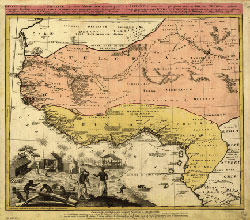 |
 |
| |

|
| |

|
| |
1743 French Map of Northwest Africa, depicting the areas covered in this curriculum unit.
Courtesy of American Memory at the Library of Congress.
|
| |
| |
| Subject Areas |
| Art and Culture
|
| |
Anthropology |
| |
Architecture |
| History and Social Studies
|
| |
World History - Africa |
| |
World History - Ancient World |
| |
World History - Asia/Far East |
| |
| Time Required |
| |
Activity 1: 2 class periods (1 for lesson; 1 for assessment)
Activity 2: 2 class periods
Activity 3: 2 class periods
Activity 4: 2 class periods
Activity 5: 2 class periods
Activity 6: 2 class periods
Activity 7: 2 class periods
Activity 8: indeterminate
|
| |
| Skills |
| |
Map skills
Observation and description
Historical interpretation and analysis
Critical Thinking
Information gathering
Visual analysis
Communication
|
| |
| Additional Data |
| |
Date Created: 10/16/03
|
|
Trekking to Timbuktu: Making The Pitch to Globe Trekker — Student Version
Using several pieces of poster board taped together, make an illustrated timeline
of the history of Timbuktu. For the illustrations, use graphics downloaded from
websites visited during this unit or draw pictures freehand. As a guide for
important dates, consult Timeline.
Your Final Presentation:
Well, you've gone “all the way to Timbuktu.” And you've made it home alive!
You've certainly discovered many of the mysteries, intrigues, and realities
of life in that remote part of the world—and you're now armed with plenty of
good reasons why someone might want to visit there.
Now it's time to convince the producers of Globe Trekkers to film an
episode there.
Hope you've saved all the notes and pictures you've taken as well as the essays
you wrote on your adventure. Your final task is to create a large poster exhibit
in which you highlight - through image and written word—the most interesting
aspects of each topic you've investigated—ie, geography, trade, early years
of Timbuktu, Mansa Musa's pilgrimage and mosque-building, the Golden Age of
scholarship, the search for the lost city of Timbuktu, and efforts currently
being made to restore the past.Use colorful language and any strategy you can
think of to grab the attention of the viewer. Remember, you're selling your
idea! Once you've completed the visual part of your presentation, start practicing
your speech.
When you're all set, make your presentation to your classmates, who will
dutifully carry out the role of the Globe Trekker producers. Good luck!
Extending your stay:
Not ready to go home? Tell your producer you have some more hot
tips to explore.
- The fame of Sundiata, a ruler of the ancient empire of Mali, is documented in the epic poem “Sundjata.” Read this story (available in libraries and online) and learn about his rise to power. For background information, go to Epic Poetry and Sundiata.
- Ibn Battuta's trip—Not long after the death of Mansa Musa, a famous traveler—Ibn Battuta—arrived in Mali and wrote about Timbuktu. Learn more about this man and his descriptions of trip by visiting the following websites: Battuta's Trip Twelve, Ibn Battuta and Ibn Batuta: Travels in Asia and Africa
- Watch a video in which an Islamic scholar of Timbuktu is interviewed. Go to Retelling the Story and click on the videos about Sankore and the ancient manuscripts.
- Take a visit to modern Timbuktu by accessing Travel (to Timbuktu)
Other Information
Standards Alignment
- NCSS-1
Culture and cultural diversity. more
- NCSS-2
Time, continuity, and change. The ways human beings view themselves in and over time. more
- NCSS-3
People, places, and environments. more
- NCSS-4
Individual development and identity. more
- NCSS-5
Individuals, groups, and institutions. more
- NCTE/IRA-12
Students use spoken, written, and visual language to accomplish their own purposes (e.g., for learning, enjoyment, persuasion, and the exchange of information). more
- NCTE/IRA-4
Students adjust their use of spoken, written, and visual language (e.g., conventions, style, vocabulary) to communicate effectively with a variety of audiences and for different purposes. more
- NCTE/IRA-7
Students conduct research on issues and interests by generating ideas and questions, and by posing problems. They gather, evaluate, and synthesize data from a variety of sources (e.g., print and nonprint texts, artifacts, people) to communicate their discoveries in ways that suit their purpose and audience. more
- NCTE/IRA-8
Students use a variety of technological and information resources (e.g., libraries, databases, computer networks, video) to gather and synthesize information and to create and communicate knowledge. more
- NGS-1
How to Use Maps and Other Geographic Representations, Tools, and Technologies to Acquire, Process, and Report Information from a Spatial Perspective
- NGS-12
The Processes, Patterns, and Functions of Human Settlement
- NGS-17
How to Apply Geography to Interpret the Past
- NGS-2
How to Use Mental Maps to Organize Information About People, Places, and Environments in a Spatial Context
- NGS-3
How to Analyze the Spatial Organization of People, Places, and Environments on Earth’s Surface
- NGS-9
The Characteristics, Distribution, and Migration of Human Population on Earth’s Surface

|